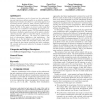Free Online Productivity Tools
i2Speak
i2Symbol
i2OCR
iTex2Img
iWeb2Print
iWeb2Shot
i2Type
iPdf2Split
iPdf2Merge
i2Bopomofo
i2Arabic
i2Style
i2Image
i2PDF
iLatex2Rtf
Sci2ools
SOFTVIS
2010
ACM
2010
ACM
Embedding spatial software visualization in the IDE: an exploratory study
Software visualization can be of great use for understanding and exploring a software system in an intuitive manner. Spatial representation of software is a promising approach of increasing interest. However, little is known about how developers interact with spatial visualizations that are embedded in the IDE. In this paper, we present a pilot study that explores the use of Software Cartography for program comprehension of an unknown system. We investigated whether developers establish a spatial memory of the system, whether clustering by topic offers a sound base layout, and how developers interact with maps. We report our results in the form of observations, hypotheses, and implications. Key findings are a) that developers made good use of the map to inspect search results and call graphs, and b) that developers found the base layout surprising and often confusing. We conclude with concrete advice for the design of embedded software maps. Categories and Subject Descriptors D.2.6 [S...
| Added | 06 Dec 2010 |
| Updated | 06 Dec 2010 |
| Type | Conference |
| Year | 2010 |
| Where | SOFTVIS |
| Authors | Adrian Kuhn, David Erni, Oscar Nierstrasz |
Comments (0)

